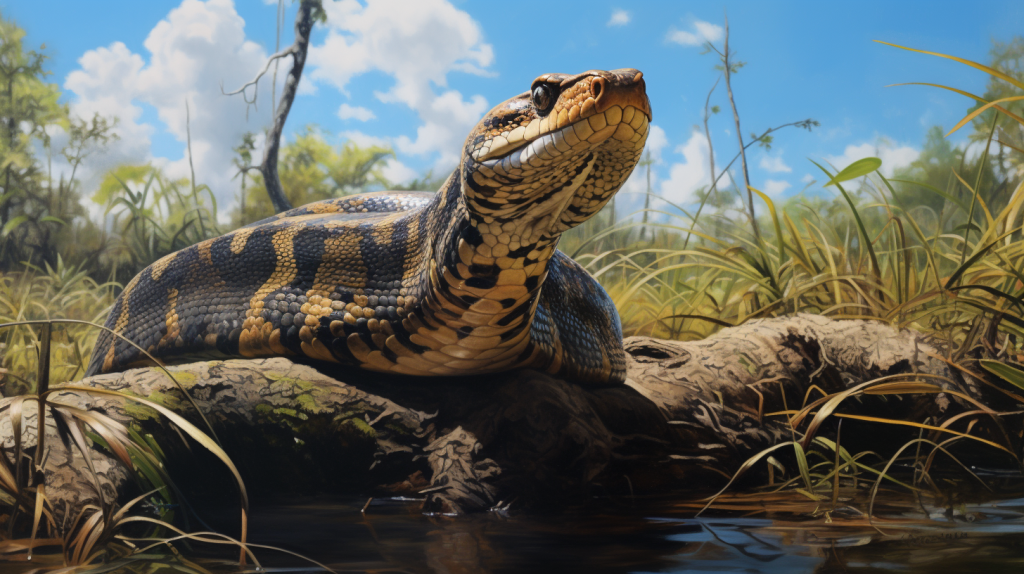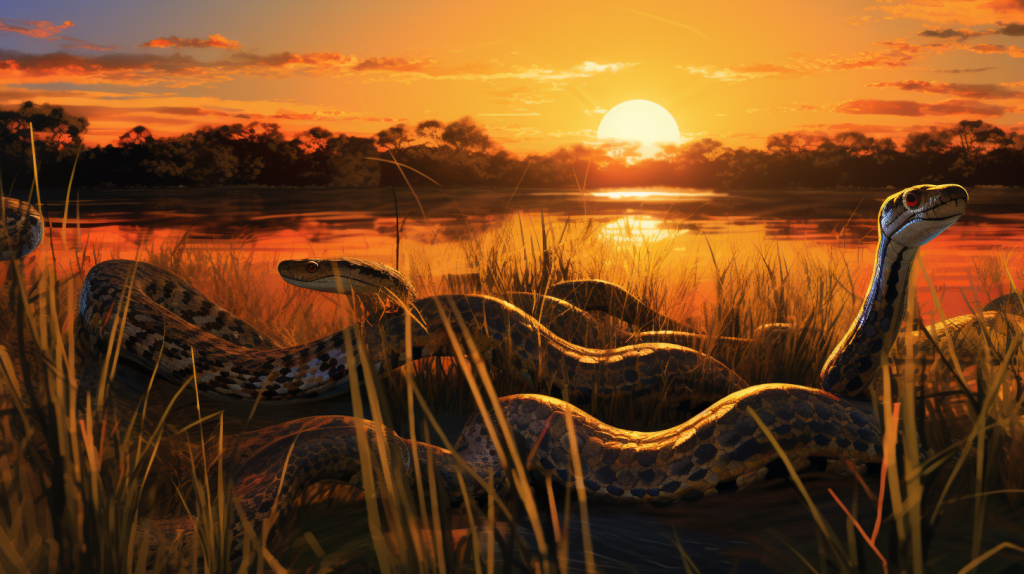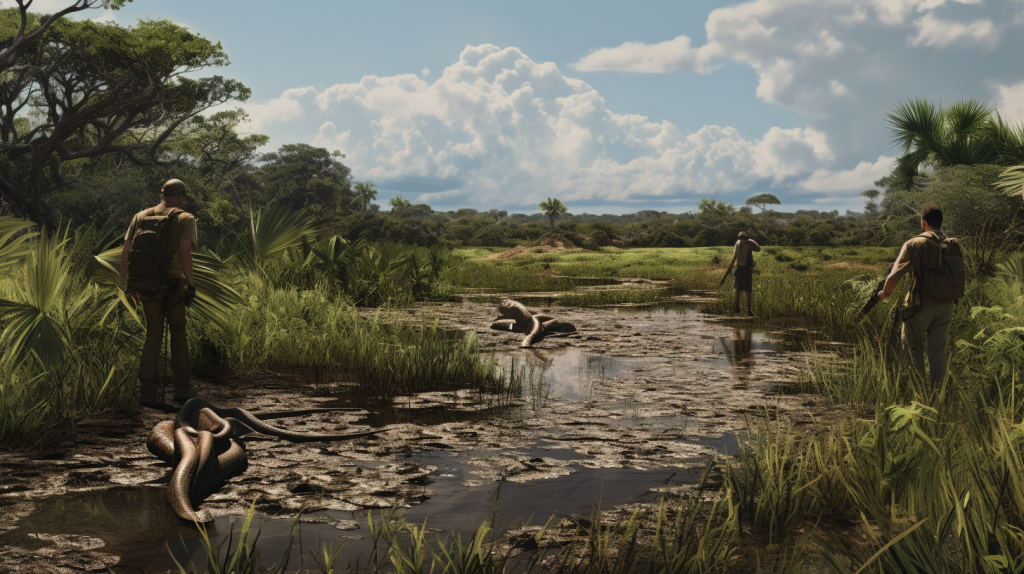Pythons in South Florida have made a name for themselves and none have have taken the spotlight like the Burmese python which can reach tremendous lengths. Florida is no stranger to the presence of invasive species, but none have garnered as much attention as this snake.
These serpentine invaders have established themselves in the region, leaving an indelible mark on the delicate ecosystem. Bursting forth from their exotic origins, these pythons have woven themselves into the fabric of South Florida’s unique environment, igniting discussions about their impact and the challenges they pose for conservation efforts.
Burmese Python In South Florida
In the heart of South Florida’s vibrant subtropical expanse, the Burmese python (Python bivittatus) takes center stage as a formidable invader. Bursting forth onto the scene during the latter half of the 20th century, these colossal constrictors have swiftly established their presence, leaving an indelible mark on the region.
With their remarkable size, often stretching beyond 20 feet, and intricate patterns adorning their scaly frames, they evoke a mix of fascination and apprehension. Yet, it’s their exceptional adaptability that truly sets them apart, enabling them to thrive in diverse habitats ranging from lush swamps to the bustling urban landscapes.
This captivating journey into the realm of Burmese pythons unravels a tale of unexpected colonization and the intricate dance between species within South Florida’s complex ecosystem.
Will Pythons Ever Leave South Florida?
As the python invasion continues, the question on many minds is whether these serpents will ever leave South Florida. Bursting into this complex narrative is the challenge of containment. While efforts have been made to control their population through removal programs and organized hunts, the adaptability of pythons has proven to be a formidable obstacle. The subtropical climate and abundant food sources in South Florida create an ideal environment for their survival, making complete eradication a challenging task.
Why Do Pythons Have To Be Caught Alive In Florida?
The battle against python invasion in South Florida has raised the question of why these pythons need to be caught alive. Bursting with controversy and ethical considerations, the emphasis on live capture stems from the potential value of scientific research. Captured pythons provide insights into their behavior, diet, and reproductive patterns, crucial information for understanding their impact on the ecosystem and developing effective management strategies. Additionally, removing live pythons helps prevent the unintentional spread of parasites and diseases that could affect native wildlife.
Are Florida Pythons Poisonous?
Addressing misconceptions is crucial when it comes to understanding the true nature of Burmese pythons in South Florida. It’s important to burst the bubble of misunderstanding and clarify that these snakes are not poisonous. Bursting forth with remarkable constriction abilities, these serpents rely on their powerful bodies to suffocate their prey, rather than injecting venom. However, the impact of these pythons on the delicate ecosystems of South Florida is undeniable.
Their insatiable appetite for native wildlife, encompassing birds, mammals, and reptiles, disrupts the natural balance and poses a significant threat to endangered species. The complexity of their role in the ecosystem bursts forth as a pressing concern, prompting the need for effective management strategies and conservation efforts to ensure the harmony of the region’s wildlife.
Bursting Hope: Conservation Efforts in South Florida
While the challenge of managing python invasion in South Florida may seem overwhelming, there is a burst of hope on the horizon. Conservationists, researchers, and wildlife agencies are bursting into action, working together to develop innovative solutions. Through a combination of removal programs, public awareness campaigns, and scientific research, there is a growing effort to mitigate the impact of pythons and restore balance to the region’s ecosystems.
Conclusion: Pythons In South Florida
We shared about the issues of pythons in South Florida and what local authorities are doing to combat this issue. As South Florida grapples with the presence of invasive pythons, the burst of complexity and uncertainty surrounding this issue continues to drive discussions and actions.
The delicate balance between human intervention and the resilience of the ecosystem adds layers of intrigue to the narrative. Bursting forth from their exotic origins, these pythons have become a defining chapter in South Florida’s ecological story, raising questions about coexistence, conservation, and the challenges of preserving the region’s natural heritage.
FAQs About Pythons In South Florida
Q: Are pythons in South Florida dangerous to humans?
Pythons in South Florida are generally not a threat to humans unless provoked. They are constrictors, meaning they squeeze their prey rather than using venom. However, caution is advised when encountering them in the wild.
Q: Do pythons in South Florida have natural predators?
Adult pythons in South Florida have few natural predators. Large alligators and humans are among the few species that can prey on them.
Q: Are python removal programs effective in South Florida?
Python removal programs play a crucial role in managing the python population in South Florida. While complete eradication is challenging, these programs help control their numbers and gather valuable data for research.
Q: Can I keep a python as a pet in South Florida?
Regulations regarding python ownership in South Florida are strict due to their invasive nature. In most cases, permits are required, and certain species may be prohibited as pets.
Q: Are there any benefits to having pythons in South Florida?
While there are no significant benefits to having invasive pythons in South Florida, their presence has sparked increased awareness about the importance of wildlife conservation and the need to protect native species.
References:
- “Python Removal Programs.” National Park Service. Link
- Florida Python Control.” Florida Fish and Wildlife Conservation Commission (FWC). Link
- “Invasive Pythons in Florida.” University of Florida IFAS Extension. Link
- “Burmese Python.” National Geographic. Link
- “Python Hunter Course.” University of Florida IFAS Extension. Link





